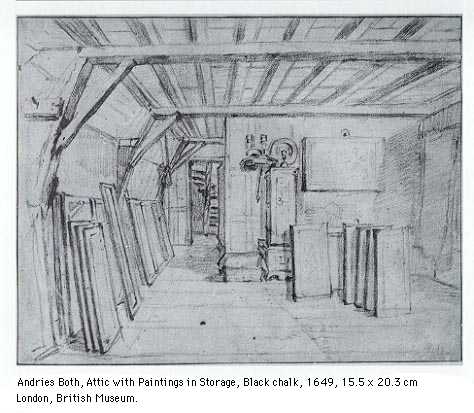
Functon of this room - which was either in the main house and/or in the annex: Storage room, probably also for the trade stock of paintings. It may have been used as a workroom, possibly for grinding paints. The maid may also have slept here (although there is no indication of a bed in the inventory).
Inventory: "A stone table to grind colours on, along with the stone, een steene tafel om verruwe te vrijven met de steen daerby ; A wicker cradle, een tiene wiech ; 13 clothes hanging sticks, dertien kleerstocken."
See the original documents from the Delft Archives. Goods owned by Catharina Bolnes, page 1, page 2, page 3, page 4, page 5, page 6, page 7. Goods jointly owned by Catharina Bolnes and Maria Thins, page 1, page 2, page 3, page 4, page 5, page 6.
See the drawing by Andries Both below!


Note : These objects were part of the Vermeer-inventory as listed by by the assistant of Delft notary public J. van Veen on February 29, 1676, in the Thins/Vermeer home located on Oude Langendijk on the corner of Molenpoort. The painter Johannes Vermeer had died there at the end of December 1675. His widow Catherina and their eleven children still lived there with her mother Maria Thins.
The transcription of the 1676 inventory, now in the Delft archives, is based upon its first full publication by A.J.J.M. van Peer, "Drie collecties...", Oud Holland, 1957, pp. 98-103. My additions and explanations are added in square brackets [__]. Dutch terms have been checked against the world's largest language dictionary, the Dictionary of the Dutch Language (Woordenboek der Nederlandsche Taal , or WNT), which was begun by De Vries en Te Winkel in 1882.
C. Willemijn Fock, Titus M. Eliëns, Eloy F. Koldeweij, Jet Pijzel Dommisse, Het Nederlandse interieur in beeld 1600 - 1900, Waanders, Zwolle, 2001, p. 27.

This black chalk drawing by Andries Both shows an attic which has another upper level, called 'vliering'. In Vermeer's house this extra level may not have existed. Vermeer was painter but also a trader in paintings. It is very likely that his trade collection of paintings was kept in the attic. There are attics in both the main house and the annex.
This page forms part of a large encyclopedic site on Vermeer and Delft. Research by Drs. Kees Kaldenbach (email). A full presentation is on view at johannesvermeer.info.
Launched December, 2002; Last update March 1, 2017.
Back to the Welcome page: click Welcome.